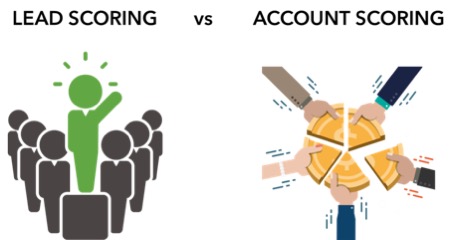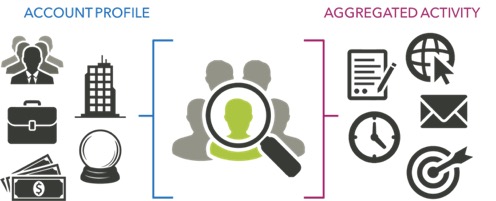
Today, fewer purchases go through a one-budget, one-decision maker process. Any purchase of size goes through a buying committee to ensure a potential solution meets the needs of all parts of the organization that may be impacted.
As a result of a shift in the buying process, sales teams are focusing more on account selling, which means that marketing’s traditional scoring approach will need to be reworked to address the unique requirements of accounts.
Here are three things to consider as you develop your account scoring model and implementation strategy:
- Individual scores may not be representative of true account interest.
Traditional scoring models score an individual. Depending on the profile information they provide and the activities they specifically take, their score will change and they will eventually qualify once their individual score reaches the specific threshold.
In the case of a buying committee, activity may be spread across multiple people:
- Someone in purchasing might be reviewing pricing information;
- Someone in IT may be validating technical capabilities; and
- Someone else may have downloaded a few customer case studies.
Any one of these records or activities by itself may not seem like much. Collectively, however, they can indicate some kind of research or buying process is going on at the account. If you were to wait for each individual contact’s record to score up and hit the threshold, it could be too little, too late — and the potential opportunity may pass before marketing or sales is given any indicator to engage.

An account scoring model helps bridge this gap by aggregating the scores across all leads and contacts associated with the account into a single, account-level score. Your account scoring model should be built separately to allow for criteria and point value adjustments. Not all lead score criteria matter to the account score, and vice versa.
Oftentimes, things like email domain or persona are not relevant to the account score, and things like annual revenue or number of locations are not really relevant to the lead record. By having two distinct but connected models, you will have the flexibility to adjust scoring without compromising the ability for marketing to qualify and sales to prioritize leads and accounts.
- Account scoring requires data to be managed differently.
Marketing-driven ABM solutions — for example, Marketo or Engagio — typically require an individual person record to have data updated or an action taken to trigger the scoring model. This generally is not an issue with account interest scoring because you want to aggregate the activity across all records to come up with a total interest score for the account.
If five people associated with an account visit some high-value content, for example, you would want the account interest score to reflect the activity for all five of those individuals. So instead of it just being 10 points, the account interest score will be 50 points.

Where this can be challenging is on the qualification side of things. Aggregating qualification data is not ideal because it can cause false positives in scoring and prioritization.
For example, if 10 people associated with one account are given 25 points each for annual revenue and number of employees, the account could end up with an account qualification score of 250. Another account with the same annual revenue and number of employees may only have five people associated with it, giving it an account qualification score of 125.
Although the score ranges can be vastly different by virtue of the number of people associated with each organization, the accounts themselves should not be prioritized any differently.
Most ABM implementations leverage a sales-defined target account list to determine which accounts are tracked and scored. Given the prequalification of these accounts, your account scoring model may not need to include all the criteria around annual revenue, number of employees, or number of locations. Sales considered all of those things when selecting the accounts in the first place.
Instead, think about scoring based on the account tier to simplify implementation and require fewer data management components. Or, consider scoring based on the target buying group (based on job title or department): the more members of the buying group, the higher the score.
- Alignment with sales and your CRM system is essential to success.
While most ABM solutions provide a way to match leads and contacts to an account, they are often limited in the ability to update account object data. This can pose a unique challenge for sharing account score data with the CRM system and sales.
Some systems may require a set of formula fields or workflow processes to take data from lead or contact records and add them to the account. Others may require a data import into the account object through an API or list load to update the account-specific data.
Whatever the solution, getting the score data to the account object is essential for account lifecycle tracking, sales routing, qualification alerts, and other follow-up activities. Data mapping and management is more complex for account scoring models because some data will live on the person record and some will need to live on the account record.
Managing this flow of data will require tight integration with the CRM and sales process to ensure that account lists and matching can dynamically update as sales modifies their targets, and account score data can be used to qualify and alert sales to potential opportunities.
Building an account scoring model provides a tremendous benefit to organizations looking to market and sell to target accounts. Coupled with traditional lead scoring, account scoring allows for quicker identification of potential opportunities and helps account teams follow up with everyone involved in the buying process.
We’ve helped several of our clients update their lead scoring strategy and move to Account-Based Marketing. Let us know if we can help you put an account-based scoring program in place, or get your Account-Based Marketing program up and running!
 Nova Kopitar is a demand generation expert, specializing in results-focused lead management, nurturing, and scoring. As a DemandGen Senior Solutions Architect, she works closely with clients in areas including program alignment, nurture development, relationship management, resource planning, reporting and more. She is Marketo Business Certified and Technical Certified.
Nova Kopitar is a demand generation expert, specializing in results-focused lead management, nurturing, and scoring. As a DemandGen Senior Solutions Architect, she works closely with clients in areas including program alignment, nurture development, relationship management, resource planning, reporting and more. She is Marketo Business Certified and Technical Certified.
The post Collective Interest Literally Adds Up: 3 Considerations When Implementing Account-Based Scoring appeared first on DemandGen.
About the Author
More Content by DemandGen
















